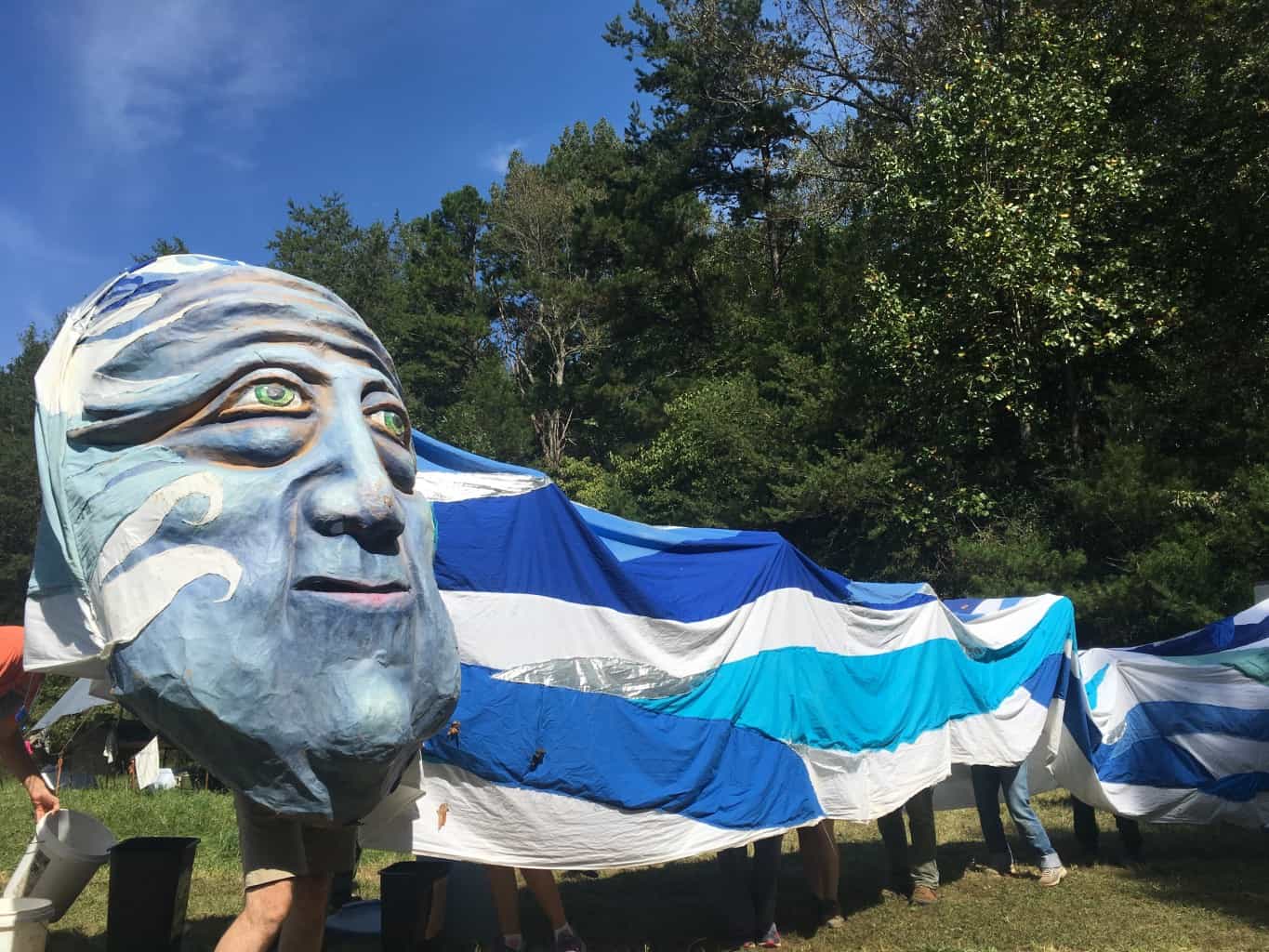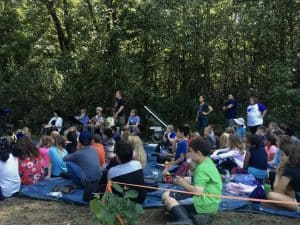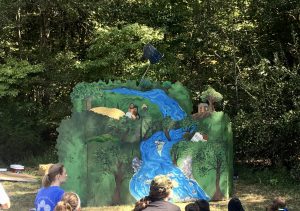River-Struck: Humans and the Haw

Last week in Bynum, the Haw River Learning Celebration kicked off its 29th year inspiring children and volunteers from around North Carolina to cultivate a friendship with the Haw. This week, the Celebration has inhabited Saxapahaw, and next it will travel to Camp Guilrock. Since 1990, the Learning Celebration has attracted over 40,000 fourth graders and 2,500 volunteers to be humans peacefully involved in the environment–an interaction which is often undermined by the bustle of today’s society. Each day, students gather with volunteers, educators, and performers at learning stations–nature art, stream ecology, animal exploration (featuring humanely collected pelts and bones!), and watershed cultural history–followed by a puppet show in collaboration with Paperhand Puppet Intervention, to explore methods of being collaborative with our river without blindly exploiting its offerings. Oftentimes, the Learning Celebration is a child’s first hands-on interaction with the river ecosystem.
I talked with Louise Omoto Kessel, festival founder, local storyteller, and director of Clapping Hands Farm in Pittsboro, about the experiences that drove her to create such a sweet part of our village community. In 1989, Louise was one of the forty Russian and American sailors and environmentalists on board the Te Vega, a schooner on a journey called the Soviet-American Sail. Two years before the Soviet Union dissolved, the Te Vega voyaged from New York City to Leningrad (now St. Petersburg) and back, serving as a platform (or deck) for cultural education, environmental research, and political activism. Their slogan, “We’re All in the Same Boat”, was a reminder that we share the oceans that divide us, and that in our ability to overcome our disunion and work together lies a peaceful future.
Louise says, “When I got back, I felt like I wanted to bring that experience home, and I also felt indebted to my community for giving me the [opportunity] to go. I get inspired by projects that bring people together and build community, especially people that wouldn’t otherwise find themselves together.” So, in late 1989, Louise got permission from the board of the Haw River Assembly (founded seven years earlier) to create a cultural, environmental, and celebratory learning initiative right in our backyards.
 That first year, volunteers gathered to travel 110 miles with the river from the headwaters in northwest Greensboro to Mermaid Point, where the Deep River and the Haw join to become the Cape Fear. Originally, the agenda included seven sites, as compared to today’s three (Bynum, Saxapahaw, and Camp Guilrock), the first of which was a small piece of land behind a trailer park. Back then, there were few public places to enjoy along the river. Louise recalls fond memories of a jug being filled from the spring at the headwaters, hauling it the whole length of the river, and then setting the aged water free into the Cape Fear, casting the magic of the Celebration downstream. She recalls the long and playful canoe journey down the Haw, and her motivations behind creating such an immersive experience for staff. “I loved the idea of the Assembly personally inspecting every inch of the river each year, and it was much more intense of an experience for the volunteers than just going out on a paddle. People came back, I called it, ‘river-struck’. My highest priority was creating an experience for the volunteers, because I felt like if we did that, those were the people that were going to show up when the Haw needed something.”
That first year, volunteers gathered to travel 110 miles with the river from the headwaters in northwest Greensboro to Mermaid Point, where the Deep River and the Haw join to become the Cape Fear. Originally, the agenda included seven sites, as compared to today’s three (Bynum, Saxapahaw, and Camp Guilrock), the first of which was a small piece of land behind a trailer park. Back then, there were few public places to enjoy along the river. Louise recalls fond memories of a jug being filled from the spring at the headwaters, hauling it the whole length of the river, and then setting the aged water free into the Cape Fear, casting the magic of the Celebration downstream. She recalls the long and playful canoe journey down the Haw, and her motivations behind creating such an immersive experience for staff. “I loved the idea of the Assembly personally inspecting every inch of the river each year, and it was much more intense of an experience for the volunteers than just going out on a paddle. People came back, I called it, ‘river-struck’. My highest priority was creating an experience for the volunteers, because I felt like if we did that, those were the people that were going to show up when the Haw needed something.”
 And, though the Celebration has grown and evolved over its twenty-nine years, the spirit of it remains intact. Louise says, “When I’ve gone back and volunteered, I feel happy that the essential spark of that experience is very much still alive.” Seeing students’ expressions shift from uncertainty to pure joy as they experience earth in most natural form is inspiration to us all, and reminds us that our impact continues with them; that with our own two hands and a little bit of community, we can restore a kind, collaborative relationship with the earth.
And, though the Celebration has grown and evolved over its twenty-nine years, the spirit of it remains intact. Louise says, “When I’ve gone back and volunteered, I feel happy that the essential spark of that experience is very much still alive.” Seeing students’ expressions shift from uncertainty to pure joy as they experience earth in most natural form is inspiration to us all, and reminds us that our impact continues with them; that with our own two hands and a little bit of community, we can restore a kind, collaborative relationship with the earth.
The Haw River Learning Celebration works closely with community businesses and generous citizens to provide meals for staff and extra funding. To volunteer, donate, or provide a meal, visit Haw River Learning Celebration.
